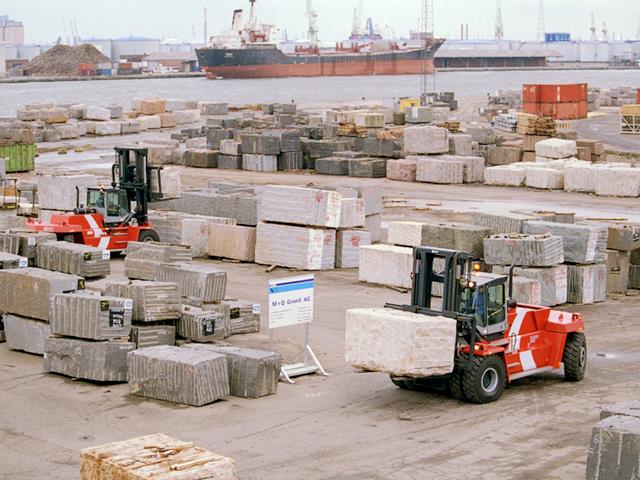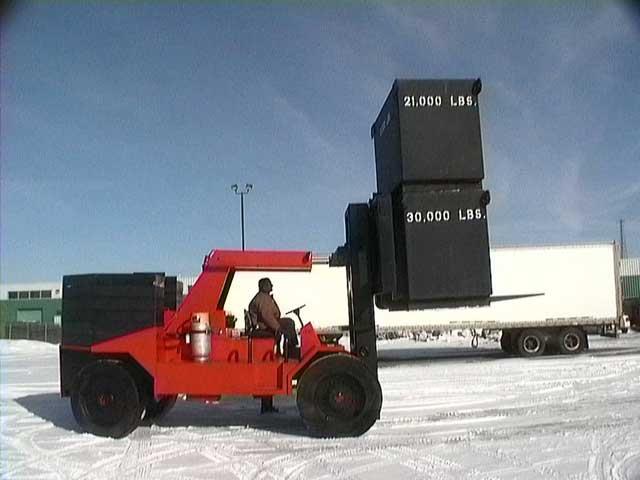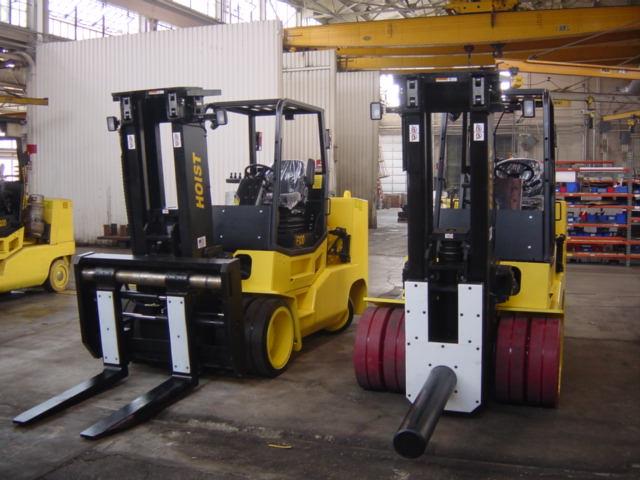by Christine LiewIn 1948, a sawmill in the small Swedish village of Lidhult needed a machine to move timber. The sawmill owners bought an old truck, turned the chassis backwards and built a forklift. The machine became the envy of other sawmill owners and a demand was created. A few years later, a forklift production plant replaced the sawmill.
That is the story of the humble beginnings of Kalmar, a forklift manufacturer that built the world's biggest forklifts (90-tonne capacity) in the early 1990s and earned itself a place in the Guinness Book of Records. Today, there are many forklift manufacturers building big lifts.
Big lift manufacturers include Kalmar, Sweden; Hyster, US; Fantuzzi, Italy; Paus, Germany; SMV Konecranes, Sweden; CVS Ferrari, Italy; Svetruck, Sweden; Linde, Germany; Taylor, US; Rigger Xtreme, Canada; Lowry, Canada; Toyota, Japan; Paling, Canada; Hoist, Canada; Royal Tractor, US; Omega Lift, Canada; Omega, Australia; Meclift, Finland; TCM, Japan; ZV, Italy; Komatsu, Japan; Mitsubishi, Japan; Dalian Forklift, China; and Daewoo, Korea and Hubtex, Germany.
In this article, we define a big lift as a forklift, container handler or reach stacker that has a minimum load capacity of 20,000lbs or 10 tonnes.Bigger lift, smaller market Stone and concrete call for Kalmar forklift trucks' heavy-duty handling. |
Big lifts are used by ports and associated container-handling industries, road and rail transport, in heavy industry, and the steel, concrete and paper mills and wood industries. Prices range from USD70,000 to USD1,000,000 although some manufacturers are hesitant to set a price range, saying instead that "every order is unique". That is because most big lifts are custom-made to customers' specific requirements.
Bill Lowry is president of
Lowry, a Canadian company that manufactures compact, cushion-tyred, internal combustion forklifts in capacities ranging from 18,000lbs (8,170kg) to 40,000lbs (18,144kg). His main competitors in North America are Taylor, Royal Tractor and Hoist.
He provides a picture of the diversity of his customers.
"Companies like Alcoa and Wise Aluminium use Lowry for handling aluminium coils, Georgia Pacific and SCA Tissue use Lowry for handling jumbo mega rolls of tissue paper and the Boeing Aircraft Company uses Lowry for handling very large and heavy raw material loads for aircraft production.
"Recently we sold multiple units of our 40,000lbs (18,144kg) capacity forklifts to a major Australian automotive manufacturer for handling automotive blanks.
"Machinery movers and riggers have (also) been great customers since our company started." Machinery movers and riggers specialise in installing and/or removing large loads, like production machinery, boilers and printing presses.
Kalmar spokesperson Lotta Sundstrom told Forkliftaction.com News the big lift market for industrial forklifts was significantly smaller than the small lift market.
"Of the total forklift market, around five per cent to 10 per cent are heavy forklifts and it has to do with a less(er) number of applications," Sundstrom said.
Kalmar has its own classification system for forklifts. The light range is five tonne to nine tonne (5,000kg to 9,000kg) capacity. Medium range is nine tonne to 18 tonne (9,000kg to 18,000kg) and the heavy range is 20 tonnes (20,000kg) and above. The Swedish company, which makes forklifts at its Ljungby and Lidhult plants, south of Sweden, does not make forklifts below five tonnes (5,000kg) and sold around 1,000 heavy industrial forklifts for the year ending December 2004.
Terry Troutman, from
Hoist, a small privately owned manufacturer with a plant in Bedford Park, Illinois, US, said his company produced compact cushion-tyre forklifts with capacities ranging from seven tonnes to 50 tonnes (7,000kg to 50,000kg) and heavy-duty, pneumatic tyre forklifts with capacities ranging from 10 tonnes to 16 tonnes (10,000kg to 16,000kg). He claims Hoist is the world's largest compact cushion-tyre forklift manufacturer.
"Overall, it is a small market. The economy has been hurt by high oil and steel prices. Import duties and taxes and transportation costs have hurt sales," Troutman said.
As a small company operating in a "small" market, Hoist's current manufacturing trend is to create commonality in parts.
"We build small quantities of these forklifts. Therefore we are designing different models to have the same parts, such as hydraulic pumps, valves and engines, so we don't have to stock or support too many different components," Troutman said. That meant better prices and deliveries for customers.
According to statistics Forkliftaction.com News obtained from forklift manufacturer associations worldwide, around 2,400 units of forklifts with capacities ranging from 10 tonnes to 18 tonnes (10,000kg to 18,000kg) were sold last year while around 350 units of forklifts with capacities above 18 tonnes (18,000kg) were sold.
Kalmar Industries product manager Per Rosengren said he estimated between 850 and 890 reach stackers were sold in 2004.
Bigger lift, smaller viewOperator visibility is an important factor for big lift manufacturers. Huge loads or many container-high loads mean operators often have their vision impeded when driving big lifts.
 Rigger Xtreme's XE120 test picking 51,000 lbs at 24" load centre. |
This year, Canadian big lift specialist
Rigger Xtreme is making its largest forklift. The company, which started two years ago after its predecessor HMS Equipment shut down, manufactures 40 ton to 100 ton (36,287kg to 90,718kg) forklifts, mostly for the machinery moving industry.
Rigger Xtreme president Michael Salter said Precision Tube, Texas, which claims to be the world's largest manufacturer of coiled steel tube and pipe, had ordered the biggest forklift his company had ever made.
The forklift, which is currently in production, will have a capacity of 200,000lbs (90,718kg) at a 24" (0.61 metre) load centre. "It is completely custom-made for Precision Tube's yard and application. Even the huge forks are specially designed for its application," Salter said.
The forks are 144" (3.66 metre) long, 16" (0.41 metre) wide and 6" (0.15 metre) thick. Salter said the forklift was the most unique truck he had custom-made for a client.
"With a small forklift it is mostly a small skid and you can view the surrounding area. With a big lift, you are picking big things, which tend to block your view, especially after you've compensated by adding a larger, thicker mast for more weight. You have a lot more blind spots, which can lead to difficult manoeuvring.
"There is a suitably large cab for this forklift we are making for Precision Tube and it has 'reverse steering'. The customer can approach the load and pick it up but, because the load is so large, it will block their forward view. All they have to do is turn around in their seat and drive in reverse by using another steering wheel and another set of levers," he said.
Geoff Beale, sales director of
Hyster Company, which manufactures forklifts with capacities up to 115,000lbs (52,163kg), said there was "very little difference" in the basic functionality of big lifts compared to small lifts but operator visibility was an important factor for big lifts.
"When dealing specifically with container handlers, the cab location is modified to promote visibility. Big trucks have a large chassis which allows repositioning. To promote visibility, the container handler's cab is at the back of the truck," Beale said.
Hyster's 40 tonne (40,000kg) capacity H1150HD-CH container handler has been in use at P&O Ports Louisiana since December 2003. Equipment manager at P&O Ports Louisiana, Gus Bertucci, said the container handler was designed to have improved visibility.
"Of all the units we've ever had, this is the best truck for visibility that I've ever seen. It's better than anything we've ever run."
Lowry said in cases where the load was exceptionally large, the operator could be guided by a "spotter"; a common practice in the machinery moving and rigging business. (A spotter is a second person who guides and directs the operator whose vision is hindered by a huge load.)
Greg Pannia, operations manager of
Omega Lift Manufacturing Inc, a privately owned Canadian manufacturer of all-terrain forklifts whose larger machines have capacities ranging from 16,000lbs (7,257kg) to 30,000lbs (13,607kg), said that, besides good visibility, big lifts should also have comfortable cabs.
"The operator must clearly see around him and the load, plus when you spend that kind of money for a forklift one would think the cab would be nice."
Bigger lift but 'small lift feel' 13-tonne P Series Hoist on LP while in testing. |
Big lifts that have larger, heavier components generally need larger areas to move around in indoors. They also need larger doorways to exit and enter and heavier floors to support them.
Rigger Xtreme and Hoist are two big lift manufacturers that claim their big lifts are physically smaller than most big lifts.
Salter explained why Rigger Xtreme's forklifts had to be physically smaller than other big lifts:
"Most customers need to transport my trucks from plant to plant. So they have to have removable counterweights and attachments to keep them "small" and "light" to move.
"We try to make a big lift but keep the 'small lift feel'. Most customers have to routinely go in and out of small buildings and plants, transporting the forklift back and forth.
"In a small forklift, you can just drive it on a float and off you go. However, with a big forklift, you have a lot more weight. We have to make a forklift that can break down to lighter loads to transport the forklift back and forth (easily)," Salter said.
"For example, with Taylor, their big lifts are mostly sold into yards where they will spend most of their life so they don't necessarily have to worry about this."
Troutman said Hoist compact trucks were smaller than "conventional forklifts of this capacity" and so must be heavier to compensate for a shorter wheel base and width.
"This is accomplished by using smaller diameter solid, press-on-type tyres. This puts more weight on a smaller surface area and creates more force on the floor. That is why floor composition is so important," he said.
Omega Lift's Greg Pannia said: "You need to make the machine feel and drive like a small lift. To do that you must use top quality engines, axles, transmissions and hydraulic pumps and motors."
Bigger lift, bigger riskBig lifts are generally used for very specific heavy lift applications that fall outside the every-day, high-cycle movement of the standard small lift. It is not only the operator who could be at risk but the cargo, which might not only be bigger in size but in cost.
Lowry said there was "zero room" for error in heavy lift applications.
"Heavy lift applications usually demand the best in operators and advance knowledge of exact weights and load centres.
"Imagine lifting 20 tons (18,144kg) or the equivalent of, say, 15 mid-sized cars at one time. Twenty tonnes lifted off the ground in any condition demands well-trained, experienced operators. Twenty tonnes being dropped or mishandled is a catastrophic event that simply cannot happen.
"You do not want an inexperienced novice operator to handle such a load. In most cases, a load that size is worth an absolute fortune and in many cases is irreplaceable," he said.
Click here to see more photos of big lifts in our Photo Gallery--
In Part 2 next week, we examine safety issues for big lifts and current design and engineering trends.